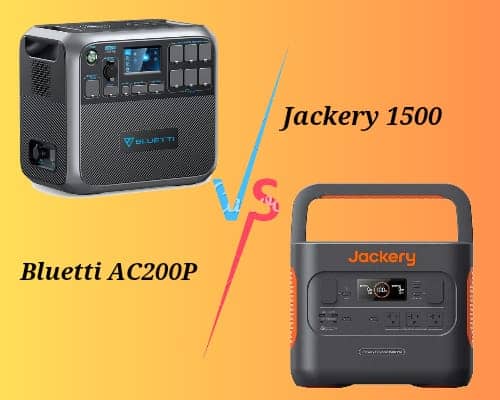
Bluetti AC200P vs Jackery 1500
Whether you’re prepping for power outages at home or seeking a reliable power source for camping and recreational activities, a portable power station can be a valuable piece of equipment. However, with multiple reputable brands on the market, it’s not always easy to choose the best option for your needs and budget.
Two top performers in this category are the Bluetti AC200P and the Jackery 1500. Both pack plenty of power in an efficiently designed package, with the ability to be recharged via solar panels or standard outlets. So which is the better buy? Let’s take a closer look at how the AC200P and 1500 compare in key areas like capacity, outputs, charging options and overall value to determine which may be the ideal portable power companion for your lifestyle.
By understanding the performance specs, features and unique strengths of each model, you can feel confident selecting the power station that most closely aligns with your power needs both now and in the future. Whether your priority is raw output potential, compact portability or advanced charging flexibility, keep reading to see where the AC200P and 1500 differ – and which may emerge as your new off-grid powerhouse of choice!
Bluetti AC200P vs Jackery 1500 in Performance
The Bluetti AC200P’s 2000Wh capacity is made possible by its robust lithium iron phosphate (LFP) battery chemistry. LFP is safer than other types as it has no risk of thermal runaway. It also maintains a high energy density over thousands of charge cycles.
Bluetti pairs this durable battery with an advanced battery management system (BMS) that monitors every cell. This allows for precise balancing to eke out the full 3500-cycle lifespan. The result is a generator that can power through multi-day outages or off-grid missions with reliability.
Meanwhile, the Jackery 1500 taps lithium-ion chemistry. Similar to LFP, it provides high power density but typically has a shorter lifespan in cycles. However, Jackery uses individual protected cell wiring that helps avoid catastrophic failures even if one cell fails.
Its monitoring tech isn’t quite as sophisticated either. But for occasional use, 500 cycles is more than enough before diminishing returns set in on replacement. Both units deliver amazing value cycle-for-cycle.
In short, while the AC200P is ultimately the champ for relentless duty, the Jackery 1500 still holds its own performance-wise – just expect more longevity from Bluetti for mission-critical applications. You can’t make a bad choice here!
Bluetti AC200P vs Jackery 1500 in Charging Options
The Bluetti AC200P has an incredibly versatile set of charging ports that allow you to juice up just about any device. It comes equipped with 4 USB-A ports for smartphones and tablets, a fast-charging USB-C PD port, an RV outlet for larger appliances, and not one but two wireless charging pads so you can simply plunk your phone down to power up. There’s also a carport for devices like your smartphone while road trippin’ and two barrel ports for additional accessories.
On top of all that, the AC200P has 4 full AC outlets so you can run small appliances, lights, fans or anything else that plugs into the wall. With 17 outlets total, you can charge a serious amount of gear simultaneously. Just be careful not to overload the outlets or you’ll likely trip the safety mechanisms.
The Jackery 1500 is no slouch when it comes to ports either. It has a USB-C, USB-A, and quick-charge USB for mobile devices. Plus a car port to keep your phone juiced in the car, and a DC outlet for other 12v accessories. While only having around 6 outlets total, it should cover basic charging needs for camping and emergencies.
The clear winner in charging flexibility is the AC200P. With over twice as many ports covering pretty much every connection type, you’ll have no problem finding an outlet for any gadget or appliance. Just manage your wattage loads carefully so you don’t overload the generators. Both are great options but the AC200P is the champ for simultaneous multi-device charging on the go.
Bluetti AC200P vs Jackery 1500 in Portability
At just over 60 pounds, the Bluetti AC200P is definitely on the heavier side compared to similar portable units. Its casing dimensions of 16.5 x 11 x 15.2 inches also mean it takes up more luggage or cargo space. All that weight is accounted for by its large capacity lithium batteries and powerful inverter/charger components though.
The Jackery 1500 is much easier to lug around at only 35 pounds. Slightly more compact measurements of 14 x 10.4 x 12.7 inches don’t buy you a huge amount of space savings, but every ounce counts when carrying long distances.
In terms of bulk alone, Jackery gets the nod. But you do sacrifice some output options and overall capacity versus the beefier Bluetti. The trade-off is convenience versus power as needs dictate.
Me personally, I’d opt for the AC200P if base camping at a location for an extended time off-grid. But the Jackery suits my lighter-weight backpacking trips where pack space is tighter. Both have their strengths – factors like your specific activity or power needs determine which feature set suits your purposes better.
Bluetti AC200P vs Jackery 1500 in Compatible Solar Charger
The Bluetti AC200P can be recharged using their 120W or 200W solar panels. Given its large capacity, the 200W SP200 panel makes the most of its power potential. However, at around $550 it’s a major investment.
The Jackery 1500 works well with up to 4 of their 100W SolarSaga panels. Each panel costs $300, making solar charging more affordable overall. What’s really handy is the Jackery includes adapter cables that allow you to fuse two-panel outputs together for faster charging.
So while both units can go solar, the modular setup and bundled accessories of the Jackery system give it an advantage. Being able to essentially use two 100W panels like a 200W panel is more flexible than relying on Bluetti’s single pricier option.
Plus the ability to expand the Jackery system over time by adding extra 100W panels makes it a smart long-term choice. The included combiner cables also just make the process much more user-friendly out of the box.
So for ease of use, affordability and expandability, the Jackery with SolarSaga panels wins out as the superior solar-charging kit. Their design clearly has sustainably powering adventures in mind. Of course, either brand makes clean energy on the go very possible.
Bluetti AC200P vs Jackery 1500 in Price and Availability
The Bluetti AC200P typically retails for $1,799, which is indeed a reasonable mid-range price point given its specs and high watt-hour capacity. However, Bluetti doesn’t tend to offer sales or discounts very often.
The Jackery 1500’s standard list price is $1,599, making it slightly more affordable right out of the gate. But Jackery also runs frequent promotions, sometimes up to 15-20% off their products. During major sales periods, you may even find it discounted down to $1,300 or below.
Availability is also favourable for Jackery. Being an established brand, they maintain the SolarSaga system components are more consistently stocked at major outdoor retailers as well as on Amazon. Bluetti products can sometimes experience longer fulfilment times.
So while you aren’t saving a fortune, either way, Jackery’s occasional promotions and widespread distribution channels make the total package cheaper in the long run versus Bluetti. Customers appreciate ease of purchase and delivery more than a nominal undiscounted price difference.
All things considered, Jackery demonstrates better value when availability, aftermarket support and overall cost are factored together. Their commitment to usability and affordability for as many people as possible gives them the win in this category. Kudos to their customer-centric business model!
Which one is better for you?
Both units are great options, so this comes down to your specific needs and priorities. The Bluetti AC200P has a clear edge in raw power output thanks to its larger capacity battery. This makes it a better fit for applications that require continuous, high-wattage power draws over long periods.
Some examples include plugging in large appliances, multiple laptops/devices simultaneously, extended backup power during an outage, or powering work tools at a remote job site for many hours per day. If unconditional heavy usage is your priority, the AC200P delivers.
However, its significantly larger size and weight mean it may not be as practical for lighter-duty or occasional use cases like weekend camping. Here the Jackery 1500 strikes a better balance of capacity and portability. Its lower price is also attractive.
So in summary – if you need a workhorse generator for demanding loads on a regular basis, go with AC200P. But for travel-friendly backup power during limited uses, the Jackery offers plenty of juice at a more affordable and compact package. Consider your specific power needs and how often you’ll rely on the generator to determine which fits you best. Both are smart investments.
My Verdict
While both the Bluetti AC200P and Jackery 1500 are excellent portable power stations, the best choice depends on your individual needs and priorities.
The Bluetti offers unmatched power and longevity perfect for applications that require continuous heavy usage over long periods. Its pure sine wave inverter also ensures sensitive electronics are protected.
However, the Jackery provides a solid balance of capacity and usability better suited for occasional or supplementary power needs where portability is important. Its affordable price also makes solar charging more accessible overall.
Really it comes down to factors like intended usage situations, available budget and weight constraints. Take time to thoroughly consider all specifications and your power requirements both present and future.
Both brands deliver industry-leading technology and customer service. So focusing first on identifying your power needs will lead you to the product best able to support your sustainable energy lifestyle for years to come, whether tackling lengthy emergencies or weekend adventures under the sun.
As always, using clean, renewable power sources benefits us individually and globally. I hope this overview has provided valuable insights into selecting the ideal partner to fuel countless journeys, large and small. Please let me know if any other questions arise during your decision process.




